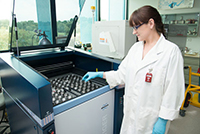News
Catch a behind-the-scenes glimpse of Geoscience Australia
Published:20 July 2015

Geoscience Australia laboratory technician
Geoscience Australia will be offering four behind-the-scene tours of our building and collections during National Science Week. Join one of these exclusive tours and wonder no more what's behind our doors.
The four tours will be offered at various times between Monday 17 and Thursday 20 August. Numbers are strictly limited, with bookings essential via Eventbrite.
See the Earthquake Alert Centre where geoscientists provide a 24/7 earthquake monitoring and alerting service to monitor the seismic signals from earthquakes across Australia. Geoscience Australia's role is to alert the nation when earthquakes occur.
This information is important for emergency services to respond rapidly and effectively to earthquake events, and to help provide warnings as part of the Joint Australian Tsunami Warning Centre. It's also vital to our understanding of Australia's susceptibility to earthquakes and to inform long term planning decisions and safer building codes.
For the first time ever, explore the world class collection of amazing specimens housed in Geoscience Australia's gem, mineral and fossil collection. Geoscience Australia is the proud custodian of this national collection that includes rare minerals from Broken Hill that can no longer be collected; and specimens collected by a number of world renowned collectors, including Australian Albert Chapman.
Discover Geoscience Australia's specialist geoscience laboratories, and learn about the microfossils used by scientists to explore for petroleum and interpret ancient environments.
Uncover the mysteries of the Sensitive High-Resolution Ion Microprobe (SHRIMP) laboratory, a rock-dating 'time machine' that uses the latest technology to discover the age of rocks. The SHRIMP uses radiometric geochronology techniques to measure the age of rock materials based on the radioactive decay of the composite mineral elements.
Further details on timing of the tours can be found via Geoscience Australia's Public Events webpage.
Email:




